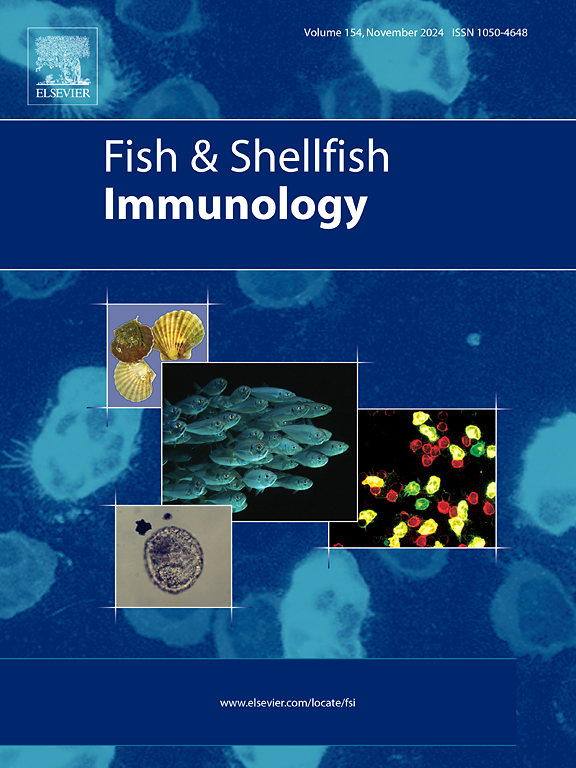Liposome encapsulating pine bark extract in Nile tilapia: Targeting interrelated immune and antioxidant defense to combat coinfection with Aeromonas hydrophila and Enterococcus faecalis
IF 4.1
2区 农林科学
Q1 FISHERIES
引用次数: 0
Abstract
Application of smart delivery systems for encapsulation of natural ingredients provides novel avenues and is being frequently developed. Thus, we aimed to highlight the effects of cyclosome liposomal pine bark extract (CL-PBE) on Nile tilapia growth, immunomodulation, antioxidant capacity and resistance against coinfection with Aeromonas hydrophila and Enterococcus faecalis and their associated virulence genes. The experiment was conducted on four fish groups receiving a control diet (control) along with three baseline meals supplemented with 200, 400 and 600 mg/kg diet of CL-PBE (CL-PBE 200, 400 and 600, respectively). At the end of the 12-weeks feeding trial, the tilapias were intraperitoneally challenged with virulent A. hydrophila strain and five days later, E. faecalis challenge was carried out. The results revealed that tilapias fed diets fortified with CL-PBE displayed significantly enhanced growth rate and feed conversion ratio in a dose-dependent manner. Moreover, we demonstrated that CL-PBE had potent antioxidant property presented by modulation of several markers of oxidative stress; substantial reductions in reactive oxygen species, hydrogen peroxide and malondialdehyde levels, an elevation in total antioxidant capacity and boosting glutathione peroxidase (GSH-Px), catalase (CAT) and superoxide dismutase (SOD) activities in fish serum and muscle tissues. This was also correlated with augmenting the expression of CAT, SOD, GSH-Px, Nrf2 and caspase-1 genes alongside reducing those of COX-2, HSP70 and iNOS genes in response to CL-PBE. Our data demonstrated that CL-PBE fortification counteracted the overly pronounced inflammatory response-mediated induction of IL-1β, TNF-α, MHCII and TLR2 genes at the transcriptional levels post coinfection together with promotion in MUC2 and IL-10 genes expression. Notably, our findings displayed optimal well-functioning fish immune system post dietary supplementation of CL-PBE for the protection against coinfection with A. hydrophila and E. faecalis. This was evident from the decline of their counts and hence encompassing the capacity to reduce cumulative mortality percentage in conjunction with interference with their virulence via the significant downregulatory effects of CL-PBE on E. faecalis esp and gelE and A. hydrophila act and fla virulence genes. Taken together, our study strongly suggested dietary inclusion of CL-PBE for Nile tilapias with superior growth performance and significant economic benefits coupled with potent stimulatory effects on antioxidant capacity and immune response expediting our detailed understanding of how coinfection with A. hydrophila and E. faecalis was controlled.
脂质体包裹松树皮提取物在尼罗罗非鱼中的应用:以相互关联的免疫和抗氧化防御为目标,对抗嗜水气单胞菌和粪肠球菌的合并感染。
应用智能递送系统封装天然成分提供了新的途径,并且正在得到频繁的开发。因此,我们旨在强调环状脂质体松树皮提取物(CL-PBE)对尼罗罗非鱼生长、免疫调节、抗氧化能力以及对嗜水气单胞菌和粪肠球菌及其相关毒力基因合并感染的抵抗力的影响。实验对四组鱼进行了试验,每组鱼的日粮分别为对照组和添加了 200、400 和 600 毫克/千克 CL-PBE 的三份基线日粮(CL-PBE 200、400 和 600)。在为期 12 周的喂养试验结束时,对罗非鱼进行腹腔注射嗜水气荚膜杆菌毒株,5 天后再进行粪肠球菌毒株注射。结果表明,罗非鱼饲喂添加了氯丙烯基弹性体的日粮后,其生长速度和饲料转化率均有显著提高,且与剂量呈依赖关系。此外,我们还发现,CL-丙烯基弹性体具有很强的抗氧化性,能调节多种氧化应激指标;能显著降低鱼血清和肌肉组织中的活性氧、过氧化氢和丙二醛水平,提高总抗氧化能力,增强谷胱甘肽过氧化物酶(GSH-Px)、过氧化氢酶(CAT)和超氧化物歧化酶(SOD)的活性。同时,CL-PBE 还能提高 CAT、SOD、GSH-Px、Nrf2 和 caspase-1 基因的表达,同时降低 COX-2、HSP70 和 iNOS 基因的表达。我们的数据表明,CL-PBE强化剂抵消了联合感染后炎症反应介导的IL-1β、TNF-α、MHCII和TLR2基因在转录水平上的过度诱导,同时促进了MUC2和IL-10基因的表达。值得注意的是,我们的研究结果表明,膳食中补充 CL-PBE 后,鱼类免疫系统的功能达到最佳状态,可有效防止嗜水青虫和粪肠球菌的双重感染。这表现在它们的数量下降,从而降低了累积死亡率,同时通过 CL-PBE 对粪肠球菌 esp 和 gelE 以及纤毛虫 act 和 fla 毒力基因的显著下调作用,干扰了它们的毒力。综上所述,我们的研究强烈建议尼罗罗非鱼在饵料中添加 CL-丙烯基弹性体,以获得优异的生长性能和显著的经济效益,同时对抗氧化能力和免疫反应具有强效刺激作用,从而加快我们对如何控制蛛网膜水虱和粪肠球菌共感染的详细了解。
本文章由计算机程序翻译,如有差异,请以英文原文为准。
求助全文
约1分钟内获得全文
求助全文
来源期刊

Fish & shellfish immunology
农林科学-海洋与淡水生物学
CiteScore
7.50
自引率
19.10%
发文量
750
审稿时长
68 days
期刊介绍:
Fish and Shellfish Immunology rapidly publishes high-quality, peer-refereed contributions in the expanding fields of fish and shellfish immunology. It presents studies on the basic mechanisms of both the specific and non-specific defense systems, the cells, tissues, and humoral factors involved, their dependence on environmental and intrinsic factors, response to pathogens, response to vaccination, and applied studies on the development of specific vaccines for use in the aquaculture industry.
 求助内容:
求助内容: 应助结果提醒方式:
应助结果提醒方式:


